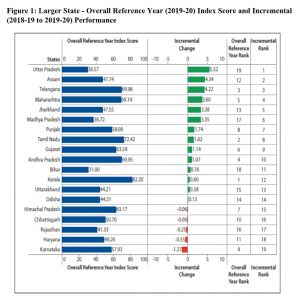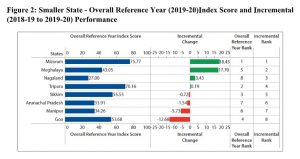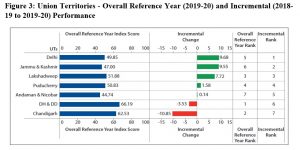
In December, NITI Aayog released the fourth edition of the state health index for the financial year 2019–20. The report, ‘Healthy States, Progressive India’, ranks states and Union territories on health outcomes. The health index score for the reference year (2019-20) provides the overall performance of states and UTs while the change in the index score from the Base Year (2018-19) measures the incremental performance.
NITI Aayog developed the state health index with the ministry of health and family welfare and the World Bank to track the health outcomes and performance of health systems in Indian states and Union territories. The idea behind the index is to nudge states/UTs towards undertaking multi-pronged interventions to achieve health-related SDGs.
A robust mechanism is followed in the whole exercise of generating the index. Data on the agreed indicators is collected online through a portal maintained by NITI Aayog or from established sources validated by independent validation agencies. The data sheets are shared with the states for confirmation, followed by video conferences for resolving disagreements and inconsistencies. The finalised data sets are used in index calculation, analysis and report writing. World Bank is involved in the entire process as a technical partner and is responsible for drafting the reports.
READ I Vaccine hesitancy in rural areas threatens India’s Covid-19 response
Methodology and indicators
The state health index is a weighted composite index based on select indicators in three domains – (i) health outcomes, (ii) governance and information, and (iii) key inputs and processes. Each domain is assigned weights based on its importance, with health outcomes carrying the highest weight. Within a domain or sub-domain, the weight is equally distributed among the indicators.
Twenty-four indicators were used in generating the index. These were selected based on their importance and the availability of reliable data, at least annually, from existing data sources such as sample registration system (SRS), civil registration system (CRS), state reports and health management information systems (HMIS). These indicators are:
Health outcomes domain: Neonatal mortality rate, under-five mortality rate, sex ratio at birth, maternal mortality ratio, modern contraceptive prevalence rate, full immunisation coverage, antenatal care registered within first trimester & proportion of pregnant women who received 4 or more ANCs, institutional deliveries, total case notification of TB, TB treatment success rate and proportion of people living with HIV on antiretroviral therapy.
READ I Sustainable development: Climate change, Covid force changes in economic priorities
Governance and information domain: Average occupancy (in months) for the last 3 years for the state-level position of health secretary, mission director and director health services, average occupancy district CMO (in months) in last three years and number of days for transfer of central NHM fund from state treasury to the implementation agency (department/ society)
Key inputs and processes domain: Shortfall of healthcare providers in public health facilities, staff covered under a functional IT-enabled integrated human resources management information system, specified type of facilities functioning as first referral units (FRUs) & public health facilities with Kayakalp score of >70% , functional health and wellness centres, district hospitals with functional cardiac care units, level of registration of births & deaths, completeness of IDSP reporting, public health facilities with accreditation certificates & district hospitals / CHCs certified under LaQshya and state government health expenditure against total state expenditure
West Bengal did not participate in the health index and DH & DD, Jammu & Kashmir and Ladakh were not included due to non-availability of data.
Takeaways from the state health index
Kerala and Tamil Nadu occupied the first and second ranks in reference year (2019-20) with overall performance scores of 82.20 and 72.42 respectively, whereas Uttar Pradesh occupied the bottom rank with an index score of 30.57. However, between the base year (2018-19) and the reference year (2019-20), the largest increase in index score (5.52 points) was observed in Uttar Pradesh while the largest decline was observed in Karnataka (-1.37 points). Apart from Karnataka, all Southern States showed improvements in the composite index scores between the base year (2018-19) and the reference year (2019-20).
Bihar, Jharkhand, Madhya Pradesh, Rajasthan, Uttarakhand, Uttar Pradesh and Odisha were in the bottom half in terms of overall performance. However, in terms of incremental performance, the picture was mixed. Uttar Pradesh, Jharkhand, Madhya Pradesh, Bihar, Uttarakhand and Odisha showed improvement in the Incremental Performance, while Chhattisgarh and Rajasthan showed marginal decline of less than half a percentage point in Incremental Performance.
Himachal Pradesh, Haryana and Karnataka are among the middle one-third Larger States in terms of Overall Performance indicating better health systems, but have negative Incremental Performance (Figure 1). Telangana emerged as the strongest performer both in terms of incremental performance as well as overall performance. Though Andhra Pradesh, Kerala, Tamil Nadu and Maharashtra were front-runners in terms of overall performance, these states showed least or moderate improvement from base year (2018-19) to reference year (2019-20).
On the other hand, Assam and Uttar Pradesh, bottom performers in terms of overall performance, fall in the category of most improved states in terms of incremental performance. Rajasthan is the weakest performer both in the case of incremental performance and overall performance.

Smaller states
The Overall Reference Year (2019-21) Index Score was the highest for Mizoram (75.77) and the lowest for Nagaland (27.00). The incremental change in state health index scores from base year (2018-19) to reference year (2019-20) varied significantly across smaller states with half of the states recording improvements. Mizoram and Meghalaya secured first and second ranks respectively in terms of incremental performance.
In addition to Mizoram and Meghalaya, positive incremental change was also observed in Nagaland and Tripura. The four states that registered negative incremental change are Sikkim, Arunachal Pradesh, Manipur and Goa. Mizoram emerged as strong performer both in terms of Incremental Performance and Overall Performance. On the other hand, Arunachal Pradesh and Manipur emerged as poor performers both in terms of Incremental Performance and Overall Performance (Figure 2).

Union territories
UT of Dadra & Nagar Haveli and Daman & Diu (DH & DD) ranked at the top whereas Andaman and Nicobar ranked at the bottom in terms of the overall reference year (2019-20) performance. Delhi and Jammu & Kashmir secured first and second ranks respectively in terms of incremental performance from base year (2018-19) to the reference year (2019-20).
Most UTs registered incremental progress, but two UTs registered negative incremental change. Delhi observed the highest incremental change of 9.7 percentage points while Andaman & Nicobar observed the lowest incremental change of 0.1 percentage points. The UT of Chandigarh (ranked at the bottom) had the largest decline of 10.9 percentage points, and the UT of DD & DH (ranked 6) had a decline of 3.5 percentage points (Figure 3).

Lakshadweep and Puducherry secured third and fourth ranks respectively in terms of overall performance as well as incremental performance. For the remaining UTs, there seems to be an inverse association between the overall reference year (2019-20) rank and the incremental rank.
The state health index is a useful tool to track performance of states and UTs. The index has triggered many useful discussions, including how to identify barriers and motivate action using data, and how to promote positive competition and learning among the states and UTs.
The MoHFW’s decision to link the state health index to incentives under the National Health Mission has been instrumental in shifting the focus from budget spends, inputs and outputs to outcomes by shining the light on states/UTs that have shown most improvement. The index has strengthened the culture of use of data at the state/UT level to monitor performance and is contributing to the agenda of improving availability, quality and timeliness of data.
Several states such as Andhra Pradesh, Assam, Chhattisgarh, Gujarat and Karnataka have replicated the index and are regularly monitoring district performance using similar tools. The process of data validation and discussions among state and central level programme managers is helping reinforce good practices related to data scrutiny and validation of HMIS data, thus improving its quality.
(Rattan Chand is Director, EGROW Foundation, a Noida-based think tank.)
